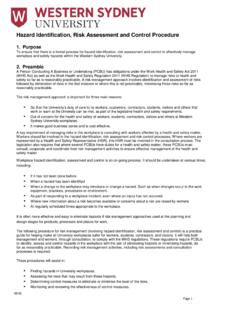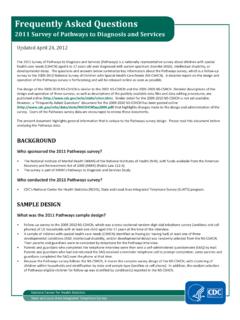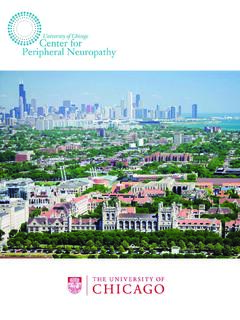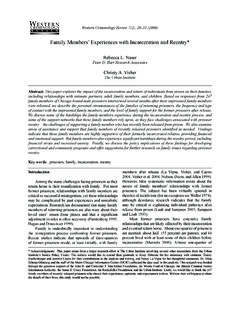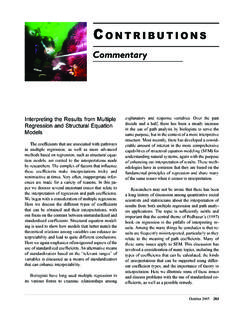Transcription of The Health Effects of Childhood Abuse: Four …
1 1 Child abuse and Neglect 2002, Vol. 6/7, 715-730 The Health Effects of Childhood abuse : Four Pathways by which abuse Can Influence Health Kathleen Kendall-Tackett, Family Research Laboratory, University of New Hampshire Objectives: This paper describes four possible pathways by which Childhood abuse relates to Health problems in adults. Method: Literature on the long-term Effects of Childhood abuse is organized in a Health psychology framework describing behavioral, social, cognitive and emotional pathways. Key studies from the Health psychology and behavioral medicine literature are included to demonstrate how these pathways relate to Health . Results: Childhood abuse puts people at risk of depression and PTSD, participating in harmful activities, having difficulties in relationships, and having negative beliefs and attitudes towards others.
2 Each of these increases the likelihood of Health problems, and they are highly related to each other. Conclusions: Childhood abuse is related to Health via a complex matrix of behavioral, emotional, social and cognitive factors. Health outcomes for adult survivors are unlikely to improve until each of these factors is addressed. Key words: child abuse , chronic illness, depression, substance abuse , social support Survivors of Childhood abuse often suffer from Health problems long after the abuse has ended. abuse survivors are sick more often and go to the doctor more (Felitti, 1991). They report more symptoms and are less likely to describe their Health as good. They have surgery more often in one study, almost twice as much (Kendall-Tackett, Marshall, & Ness, 2000). Adult survivors are at increased risk of having one or more chronic pain syndromes (Drossman et al.)
3 ,1990; Kendall-Tackett, 2000; Schofferman, Anderson, Hinds, Smith, & White, 1992). And in the Adverse Childhood Experiences (ACE) study, Felitti and colleagues (Felitti et al., 2001) found that subjects who experienced four or more types of adverse Childhood events were at increased risk of a wide range of conditions including ischemic heart disease, cancer, stroke, chronic bronchitis, emphysema, diabetes, skeletal fractures, and hepatitis. The Childhood events that they studied included psychological abuse , physical abuse , contact sexual abuse , exposure to substance abuse , parental mental illness, exposure to violent treatment of the mother or stepmother, and exposure to criminal behavior. Over the past decade, researchers have documented the higher frequency of these Health problems among adult survivors.
4 The next step for researchers is to understand why this happens. In this paper, a model with four possible pathways by which victimization might influence Health is described. By looking at the long-term Effects of Childhood abuse in a new way, clinicians and researchers can begin to understand the mechanisms by which Health problems occur. The four types of pathways described are behavioral, social, cognitive and emotional. Adult survivors can be influenced by any or 2all of these and the four types influence each other. Indeed, they form a complex matrix of interrelationships, all of which influence Health . Behavioral Pathways The behavioral pathways are perhaps the best known of the four pathways described. Anyone familiar with the child maltreatment literature will not be surprised to learn that adult survivors of child maltreatment are more likely to engage in harmful activities.
5 Below is a summary of these findings. Each of these behaviors is obviously harmful to Health . Substance abuse Not surprisingly, adult survivors are at increased risk of abusing alcohol and drugs. In the ACE study (Felitti et al., 2001), subjects who had experienced four or more adverse Childhood events were more likely to consider themselves as alcoholics, have used illegal drugs, and have injected drugs. In another primary-care sample, those with a history of victimization were more likely to use recreational and intravenous drugs (Kendall-Tackett et al., 2000). Similarly, in a study of gay and bisexual men, sexual abuse survivors were more likely to use psychoactive drugs (Bartholow et al., 1994). Similarly, in a study of female survivors of sexual abuse , these women were 10 times more likely to have a history of drug addiction and two times more likely to have been alcoholics than members of the control group (Briere & Runtz, 1987).
6 Obesity & Eating Disorders Obesity is also more common among adult survivors of Childhood abuse . In a study of 131 HMO patients with a history of incest, 60% of these patients were more than 50 lbs overweight, compared with 28% of the control group. Twenty-five percent were more than 100 pounds overweight compared with 6% of the control group (Felitti, 1991). Felitti had a similar finding in the much-larger ACE study, with the odd ratio of severe obesity equal to (Felitti et al., 2001). Study findings are mixed with regard to sexual abuse and eating disorders, but some researchers have found a relationship. For example, Miller, McClusky-Fawcett, and Irving (1993) found that significantly more young women diagnosed with bulimia reported sexual abuse after age 12 with an adult relative than did a group of matched controls (15% vs.)
7 1%). However, the relationship between sexual abuse prior to age 12 was nonsignificant. The authors conservatively suggest that sexual abuse may be related to the onset of bulimia for some women. Others, however, have not found a relationship between bulimia and past abuse (Kinzl, Traweger, Guenther, & Biebl, 1994; Rorty, Yager, & Rossotto, 1994). Suicide Suicide attempts and ideation are also common among adult survivors. The percentages are particularly striking in clinical populations, but the rates are high in community samples as well. In a community sample from Europe, 43% of CSA 3survivors had suicidal ideation and 14% had made suicide attempts (Teegan, 1999). Similarly, patients in the ACE study (Felitti et al., 2001) who had experienced four or more types of family dysfunction were at dramatically increased risk of attempted suicide.
8 A study of gay and bisexual men in treatment for STDs also demonstrated that those with a history of child sexual abuse were significantly more likely to have suicidal thoughts or actions (Bartholow et al., 1994). Finally, in two studies with samples from psychiatric emergency rooms, patients who had a history of either child sexual or physical abuse were significantly more likely to have thought about or attempted suicide (Briere, Woo, McRae, Foltz, & Sitzman, 1997; Briere & Zaidi, 1989). High-risk Sexual Behavior Risky sexual behavior is the most highly documented form of harmful behavior in abuse survivors. This finding holds true for males and females, and is consistent across the range of sexual orientations. Sexual abuse was related to high-risk sexual activities in four different community samples from Australia (Ferguson, Horwood, & Lynskey, 1997), New Zealand (Fleming, Mullen, Sibthorpe, & Bammer, 1999), Norway (Grimstad & Schei, 1999), and the United States (Felitti et al.)
9 , 2001). Young women with a sexual abuse history had earlier onset of consensual sexual activity, and higher rates of teen pregnancy, multiple sexual partners, unprotected intercourse, and sexually transmitted disease. The findings were particularly pronounced for women whose abuse experience included intercourse (Ferguson et al., 1997). Women with a sexual abuse history reported earlier age at menarche and at first sexual activity (Grimstad & Schei, 1999), and were more likely to have had an abortion (Fleming et al.,1999). Finally, men and women who had experienced four or more types of family dysfunction were more likely to have had 50 or more sexual partners, and to have had a sexually transmitted disease (Felitti et al., 2001). The findings are similar in specialized populations. In a study of incarcerated youth, girls with a history of sexual abuse reported an earlier mean age of first intercourse and were less likely to use contraception compared with their nonabused counterparts (Mason, Zimmerman, & Evans, 1998).
10 In a study of women treated for sexually transmitted diseases (STDs), researchers found that sexual abuse survivors were more likely to have had two or more sexual partners in the past 90 days (57% vs. 30%; Thompson, Potter, Sanderson, & Maibach, 1997). Gay and bisexual men with a history of child sexual abuse were more likely to have unprotected anal intercourse, and had a two-fold increase in the prevalence of HIV infection compared with gay and bisexual men who had not been sexually abused (Bartholow et al., 1994; Zierler, Feingold, Laufer, Velentgas, Krantrowitz-Gordon, & Mayer, 1991). Carballo-Dieguez and Dolezal (1995) reported similar findings in their study of Puerto Rican men who had sex with other men. Those who had been sexually abused before age 13 were more likely to participate in anal intercourse without 4protection compared with men in their sample who had not been sexually abused before age 13.


